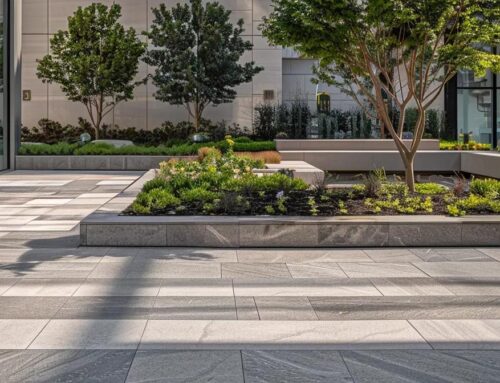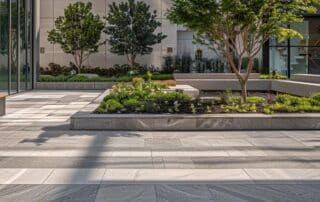The right hardscape materials can transform your walkways from ordinary to inviting. Many homeowners struggle to choose the best options that not only look great but also provide durability and ease of maintenance. In this article, I will explore various hardscape materials, key factors for selection, and the latest trends. You will gain clarity on which materials suit your project’s needs, helping you avoid costly mistakes. By addressing common challenges, this guide will ensure you make informed choices for lasting results in your outdoor spaces.
Assessing Suitability of Various Hardscape Materials

In assessing the suitability of hardscape materials for your walkways, it’s essential to explore the benefits of concrete, known for its durability in various yard conditions. I’ll also highlight the unique qualities of natural stone, which adds a natural touch to your landscape, and evaluate brick’s strength and aesthetic appeal. Additionally, I’ll compare eco-friendly options like gravel and grass, along with analyzing the use of pavers in modern walkway designs. For localized solutions, consider searching for “hardscape landscape near me” to find professionals in your area.
These insights will ensure your walkway aligns with your driveway and irrigation needs while remaining functional for maintenance tasks, such as mowing.
Exploring the Benefits of Concrete for Walkways
When it comes to walkways, concrete stands out due to its remarkable durability and resilience against water damage. I frequently recommend concrete for its easy maintenance; it resists stains better than many alternatives, ensuring that your pathway remains aesthetically pleasing over time. Whether you’re connecting your home to a garden trail or leading up to your driveway, the use of concrete pavers can provide a clean, modern look while effectively handling the demands of foot traffic.
Understanding the Unique Qualities of Natural Stone
Natural stone is an exceptional choice for walkways, offering both aesthetic appeal and long-lasting durability. I appreciate its unique textures and colors, which can bring character to any lawn while blending seamlessly with the surrounding environment. Additionally, materials like decomposed granite provide a stable surface that allows for proper drainage, reducing the accumulation of debris and preventing moss growth, making maintenance easier while enhancing the overall home improvement experience.
- Natural stone enhances aesthetic appeal
- Unique textures and colors add character
- Decomposed granite offers stability and drainage
- Reduces debris accumulation
- Minimizes moss growth for lower maintenance
Evaluating the Strength and Aesthetics of Brick
Brick offers a classic beauty that can enhance any walkway, combining strength with timeless elegance. I often recommend brick for its durability, which stands up well against erosion and the daily wear and tear from foot traffic. Moreover, when paired with stamped concrete or used creatively as a tile pattern, brick can create a stunning and unique design that adds significant charm to your outdoor space, making it an excellent choice for your hardscape landscape. Whether you’re searching for “brick hardscape landscape near me” or consulting with a professional, brick is a versatile option.
Comparing Eco-Friendly Options Like Gravel and Grass
When considering eco-friendly options for walkways, both gravel and grass present unique benefits that cater to sustainability while enhancing your landscape. Gravel offers durability with minimal maintenance, allowing for effective drainage, which is essential in preventing water accumulation and promoting healthy vegetation. On the other hand, a grass pathway can be visually appealing, providing a natural look that complements your outdoor spaces while requiring attention to ensure proper growth and upkeep, especially during dry seasons. Combining porcelain accents with these materials can further enhance the overall design, creating a cohesive aesthetic that complements your home’s style.
Analyzing the Use of Pavers in Modern Walkway Designs
Pavers have become a popular choice in modern walkway designs due to their versatility and aesthetic flexibility. I often utilize pavers that come in various textures and colors, allowing for creative layouts that enhance the visual appeal of sidewalks. For added durability and stability, the proper use of mortar or grout ensures that these elements stay securely in place, providing a functional yet stylish solution for outdoor pathways.
Choosing the right material is not just about looks; it shapes the function of your space. Next, let’s look at what matters most in making that choice.
Key Factors Influencing Material Selection

When selecting hardscape materials for your walkways, several key factors come into play. First, I consider foot traffic and usage patterns to ensure durability. Evaluating the climate is essential for understanding how materials like crushed stone or clay withstand local conditions. I also assess aesthetic preferences, alignment with landscaping styles, and estimating your budget and long-term maintenance costs. Lastly, exploring local material availability is crucial to guarantee a cost-effective and efficient project.
Considering Foot Traffic and Usage Patterns
When I assess the suitability of materials for a walkway, I prioritize the expected foot traffic and usage patterns. For high-traffic areas, such as paths leading to a fire pit or patio, I often recommend durable choices like concrete or porcelain tile, as these can withstand significant wear and tear. Additionally, ensuring proper lighting along the walkway enhances both safety and aesthetics, while a quality sealant can protect surfaces and prolong their lifespan, making maintenance simpler.
Evaluating Climate Impact on Material Durability
When evaluating the impact of climate on material durability, I consider how different substances respond to weather conditions over time. For instance, limestone, a common sedimentary rock used in landscaping, can withstand varying temperatures but may degrade if exposed to extreme moisture without proper drainage systems in place, particularly in areas near a pond or wet soil. Understanding these dynamics helps me recommend materials that not only complement your design but also endure the local climate effectively, ensuring long-lasting results for your walkway:
- Assess how materials like limestone react to local humidity and precipitation.
- Determine drainage needs for areas near ponds or moist soil.
- Consider temperature variations and their effects on various hardscaping options.
- Match material choices with the expected climatic conditions for long-lasting durability.
Assessing Aesthetic Preferences and Landscaping Style
Assessing aesthetic preferences and landscaping style is critical when selecting hardscape materials for your walkways. If you’re searching for hardscape landscape near me options, I recommend considering how different materials, like cement or natural stone, align with your existing design elements, such as a fence or retaining wall. By harmonizing the walkways with surrounding features, including existing bark or garden beds, you can create a cohesive look that enhances your outdoor space.
- Evaluate how hardscape materials complement existing design elements.
- Consider materials like cement for modern aesthetics or natural stone for a rustic appeal.
- Ensure that the walkways work well with other features, such as fences and retaining walls.
- Incorporate plants and bark for additional texture and visual interest.
Estimating Budget and Long-Term Maintenance Costs
When estimating your budget for hardscape materials like cobblestone or other options, it’s vital to consider not only the initial costs but also long-term maintenance expenses. For instance, environmentally friendly choices may require different upkeep strategies, particularly in areas prone to snow or heavy rain. I encourage you to factor in accessibility, especially if you need wheelchair-friendly pathways, ensuring the chosen materials can handle seasonal conditions while remaining practical and aesthetically aligned with your garden design.
Exploring Local Availability of Materials
When selecting hardscape materials, it’s essential to consider their local availability, as this can significantly impact both costs and project timelines. I find that materials like slate and travertine may be more readily accessible in certain areas, providing homeowners with options that match their aesthetic preferences while ensuring durability. By understanding the construction market in your region and sourcing materials locally, you can enhance the longevity of your project while also supporting community resources.
Understanding the key factors in material selection paves the way for deeper insights. Now, let’s examine the common hardscape options and their unique strengths.
Installation Techniques for Different Hardscape Materials

I will cover essential installation techniques for various hardscape materials that are crucial for creating durable and appealing walkways. First, I’ll share best practices for concrete installation, ensuring a solid foundation. Then, I’ll discuss effective methods for laying natural stone, followed by creative brick layout patterns to enhance visual interest. Additionally, I’ll provide paver installation tips for stability and longevity, concluding with important maintenance tips to keep your walkways looking great over time.
Best Practices for Concrete Installation
When installing concrete for walkways, I prioritize a solid foundation to ensure durability and longevity. First, I prepare the soil by compacting it and adding a base layer, which helps prevent settling over time. I also recommend using quality concrete mix and incorporating proper reinforcement, like rebar or wire mesh, to enhance strength, especially in areas with high foot traffic.
Techniques for Natural Stone Laying
When laying natural stone for walkways, I emphasize careful planning and proper techniques to ensure a stable and visually appealing surface. Start by excavating the area to a depth that accommodates both the stone and a compacted sub-base, using materials like gravel for drainage, which reduces settling over time. I recommend laying stones with minimal gaps, adjusting as necessary for an even surface, and securing them with polymeric sand to prevent movement and enhance stability.
- Excavate the area to the appropriate depth
- Use gravel for effective drainage
- Lay stones with minimal gaps for stability
- Secure with polymeric sand to prevent movement
Brick Layout Patterns for Visual Interest
When considering brick layout patterns for your walkways, I often emphasize the importance of creativity in design. Patterns such as herringbone or basketweave not only enhance visual interest but also contribute to the stability of the pathway, allowing for effective drainage. By experimenting with colors and sizes, I can create a bespoke look that complements your home’s style, ensuring your walkways are both functional and aesthetically appealing.
Paver Installation Tips for Stability and Longevity
When installing pavers for your walkways, I emphasize the importance of preparing a solid base to ensure stability and longevity. Start by excavating the area to the appropriate depth and applying a layer of compacted gravel, which promotes drainage and prevents shifting over time. As I lay the pavers, I recommend maintaining consistent joints and using a high-quality sand to fill in gaps, thereby keeping the surface secure while enhancing the overall appearance of your walkway.
Maintenance Tips Post-Installation for Various Materials
After installing your hardscape materials, regular maintenance ensures they remain visually appealing and functional. For concrete walkways, I recommend applying a sealant every few years to protect against stains and weather damage. Natural stone may require occasional cleaning with a gentle detergent and reapplication of joint sand to prevent shifting, while brick pathways can benefit from a quick blow to remove debris and a periodic refresh of the sand between bricks to maintain their alignment.
- Apply a sealant on concrete every few years
- Clean natural stone with a gentle detergent
- Reapply joint sand for natural stone stability
- Blow debris off brick paths regularly
- Refresh sand between bricks periodically
Conclusion
Selecting the right hardscape materials for your walkways is crucial for achieving durability and aesthetic appeal in your outdoor spaces. By evaluating options like concrete, natural stone, brick, and eco-friendly alternatives, you can ensure your walkways not only withstand foot traffic but also complement your landscaping style. Understanding factors such as climate, foot traffic, and local material availability will guide you in making informed decisions that align with both functionality and design. Ultimately, investing time in choosing the best materials will enhance your property’s value and create an inviting environment for years to come.




